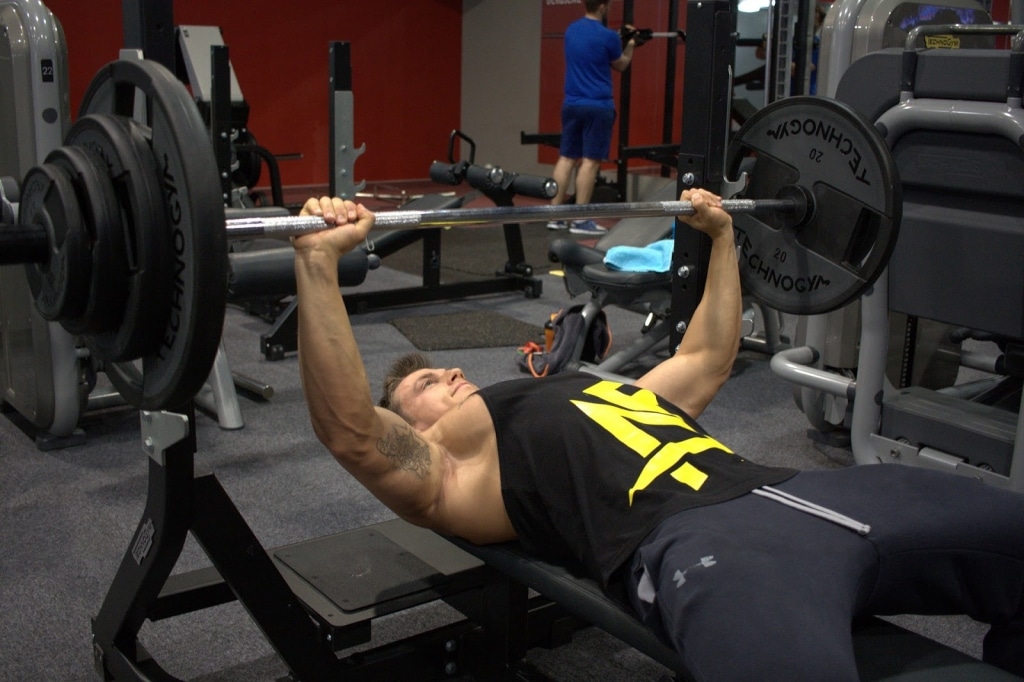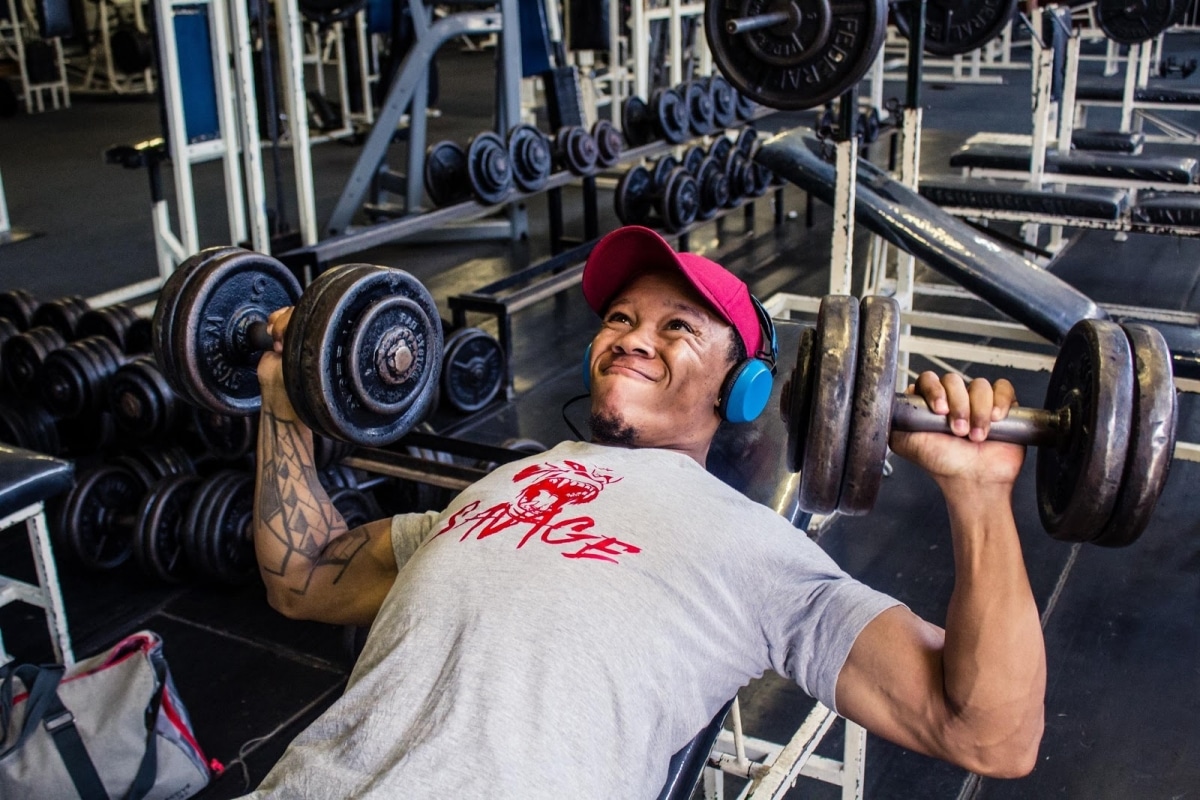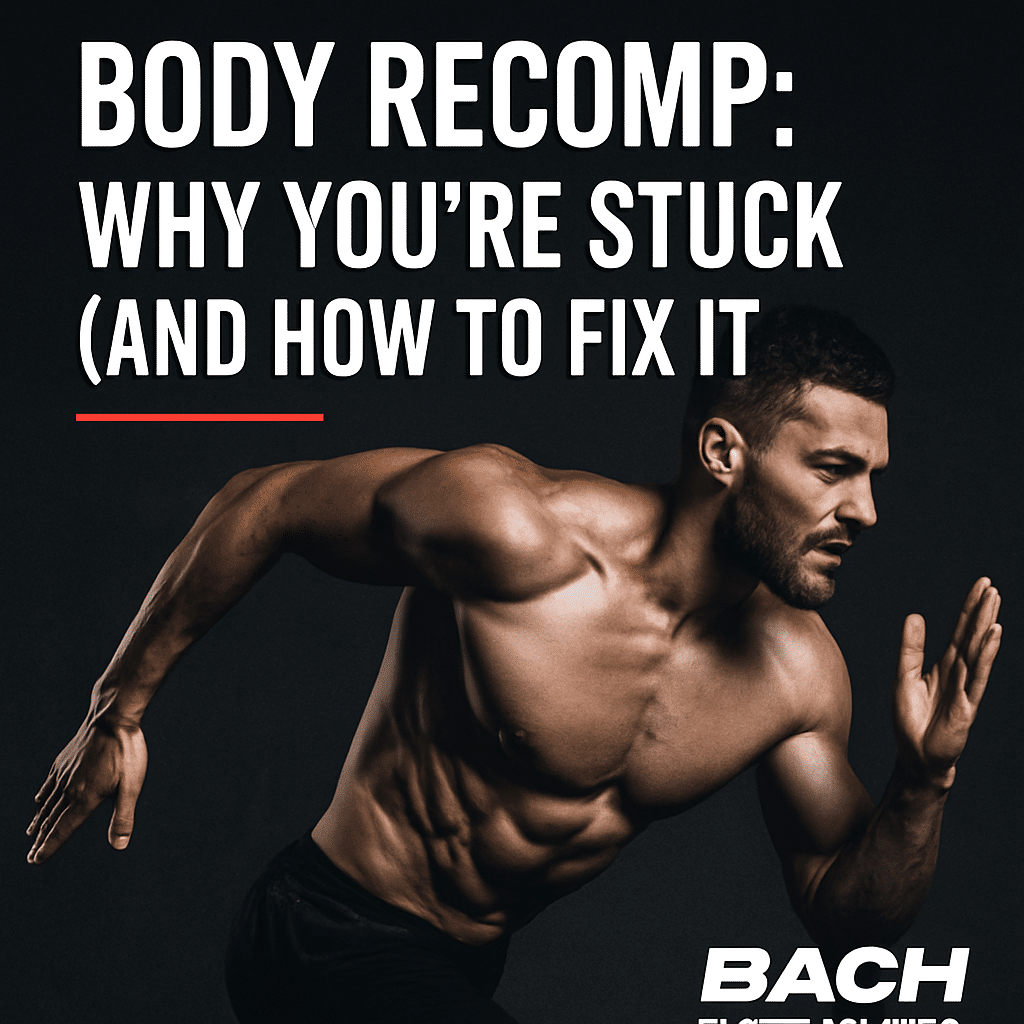Bye-Bye Barbell Bench Press: Chisel Your Chest With Dumbbells Instead
August 7, 2019
Guest Post By Johnnie Perry, Jr.
Every guy with a flat chest or saggy man boobs wants a chiseled, muscular chest. But many are going about it all wrong by using a barbell when dumbbells would be a better choice. I know it sounds crazy.
After all, as a scrawny teenage kid entering the gym for the first time, I knew what I wanted more than anything else: add size to my chest. I was a 150-pound newb lifting around grown-ass men performing one lift more than any other exercise: the barbell bench press.
 I mean, this is America, right? And the bench press ranks right up there with motherhood and apple pie as a good thing. The saying: “how much do you bench, bro?” was invented for a reason. Along with the squat and deadlift, the bench press has long been seen as a true measure of brute strength. But if you want your chesticles to be a spectacle, leave the barbell alone and head straight for the dumbbells.
I mean, this is America, right? And the bench press ranks right up there with motherhood and apple pie as a good thing. The saying: “how much do you bench, bro?” was invented for a reason. Along with the squat and deadlift, the bench press has long been seen as a true measure of brute strength. But if you want your chesticles to be a spectacle, leave the barbell alone and head straight for the dumbbells.
Here’s what you’re doing wrong and what to start doing right instead.
 Your Bar Path is Terrible: After you take the bar off the rack, you’re probably dropping it down to your chest and lifting back up in a straight line. That’s incorrect. Line the bar directly above your shoulders. Lower the bar to slightly above your sternum and keep your elbows tucked toward the ribcage. As you press back up, return to where you started.
Your Bar Path is Terrible: After you take the bar off the rack, you’re probably dropping it down to your chest and lifting back up in a straight line. That’s incorrect. Line the bar directly above your shoulders. Lower the bar to slightly above your sternum and keep your elbows tucked toward the ribcage. As you press back up, return to where you started.
Instead of Using Your Chest, You’re Using Your Shoulders: Have you been benching for a while and your shoulders look phenomenal, but your pecs resemble sacks of fat hidden underneath your shirt? If so, you obviously have a tough time recruiting them. Your shoulders and triceps are performing the overwhelming majority of the movement. Try lightening the weight. Practice retracting your shoulder blades and tightening the lats. Focus on using your chest without letting your elbows flare out.
You’re Bouncing the Barbell Off Your Chest: Are you a competitive powerlifter? No? Then stop doing this. Your sternum shouldn’t act as a trampoline for the barbell. There’s no benefit, and you’re killing the most important phase of the movement — the eccentric portion. Doing this will cause a loss of upper back tightness, control, and the inability to produce maximum force.
You’re Not Lowering the Barbell Low Enough: While you shouldn’t bounce the bar off your chest, it should be lowered to just above it. Focus on lowering the bar efficiently and using your pecs, not your shoulders. If you don’t, a serious injury may occur or your shoulders will continue growing, leaving you with an unattractive sunken chest.
It’s Better for Making You Stronger: Maximizing mechanical tension is a driver of strength. Adding weight to the bar is easier when you can add 2.5 lbs to each side of the bar. Getting stronger with dumbbells requires you to improve 5 lbs at a time.
Why Dumbbells Will Chisel Your Chest
#1 – You’ll Have Increased Range of Motion
Do you experience achy, nagging shoulder pain when benching?
Imagine being able to get the chest you want without aggravating your shoulders.
Does that sound good? Yeah? Pay close attention to the next part.
Switching from the barbell to dumbbells to build a bigger chest allows you to lower and lift the weight in a natural path for your shoulder joint.
The dumbbells enable your pecs to use more horizontal adduction at the top of the movement. In addition, if you position the angle of the dumbbells at 45 degrees, you’re taking the stress away from your anterior deltoids. This will allow for a better mind-muscle connection with the pectoralis major thus creating a better peak contraction.
Many clients in the JP Fitness Coaching Program with achy shoulders primarily use dumbbells for pressing exercises. The lack of pain has made training consistent and led to better results.
#2 – You’ll Get Better Muscle Activation
In 2016, researchers conducted a study to investigate muscle activation, total repetitions, and training volume for three bench press variations: Smith machine, barbell, and dumbbell bench press. Nineteen men performed three testing protocols in random order, and each was followed by sets of a tricep extension exercise. EMG activity was measured for the pectoralis major, anterior deltoid, biceps brachii, and triceps brachii. Each protocol involved four sets with a 10RM load and two-minute rest intervals between sets and exercises.
Guess what happened?
The dumbbell bench press elicited significantly greater pectoralis major activity versus the barbell bench press.
#3 – You’ll Reduce Muscle Imbalances
Do you have one man boob that’s bigger than the other?
Is there a significant strength difference when you go from the barbell to dumbbells?
If the answer to either of those is yes, then you need to start using dumbbells to address the issue.
The dumbbells will prevent you from favoring one side since each will be working independently. The enhanced ability to isolate each pec will lead to more balanced chest development and improve your strength over the long haul.
How to Chisel Your Chest
Use the 12-8-15 Method.
Growth factor sets typically use three different movement patterns to create lactate accumulation in the targeted muscle group. In other words, you want to feel the burn.
Here’s how you do it:
- Use an isolation exercise to pre-fatigue the muscle
- Follow it with a compound exercise to stimulate growth
- Finish with an exercise that creates post-fatigue and gets your muscles to burn
A1. Incline Dumbbell Flye 3 x 12, 3010 tempo, 30 seconds rest
The goal isn’t to lift heavy and go as fast as possible. Use lighter weights and go slow.
A2. Incline Dumbbell Squeeze Press 3 x 8, 3011 tempo, 30 seconds rest
Make sure you can keep constant tension by flexing your chest against the resistance.
A3. Decline Push Up 3 x 15, 3010 tempo, 90-120 second rest
Chisel One Pec at a Time
When you include the unilateral incline or decline dumbbell press in your routine for a bit, you’ll appreciate a better mind-muscle connection.
By using a unilateral movement, you can expose weaknesses in muscle activation, possible overcompensation by other muscles (specifically the anterior delts), plus core and shoulder stabilization issues. The best way to expose any of these weaknesses is to accentuate the eccentric part of the movement.
Use an eccentric of 4-6 seconds. Allow the muscle to stretch in the bottom position for 1-2 seconds. Then, use a concentric of 1-2 seconds followed by 0 seconds at the top. The total time under tension for the set should be 40-60 seconds. Tempos of 4220 or 5210 for 5-10 reps work well.
Create Muscle Damage and Extend the Set
The eccentric action and amount of force you can produce will be key. To create muscle damage, we want to create micro trauma to the muscle cells. This is best done by utilizing a maximal eccentric action which will recruit your fast-twitch muscle fibers. These fibers are more responsive to muscle growth. The best exercises to create damage are the incline dumbbell press and flat dumbbell press.
During the eccentric portion, control the weight 3/4 of the way down using a tempo of four seconds. On the last 1/4 of the range of motion, accelerate down and try to produce more acceleration as you switch to the concentric phase of the lift. Use 70-85% of your 1RM for 6-10 reps for each set.
Now that you’ve created micro-trauma to your muscle cells, it’s time to go a bit further. After 2 regular sets, use either a rest/pause or a drop set to go beyond failure on 1-2 extending sets.
If you’re going the rest/pause route, put the weight down after your last rep. Then, wait 10-15 seconds before picking the dumbbells up and pumping out as many reps as possible until acceptable form breaks.
To perform a drop set, complete your set then lower the weight by 25% and hit as many reps as your chest can handle.
Take Action Now. Your Chest Needs It.
Building a chiseled chest means you can’t sacrifice time or waste energy doing things that don’t matter. Imagine this…
The dumbbells are your chisel. Your chest is a blank slate of stone.
Get to work. Carve out a carefully crafted chest that builds confidence and makes you feel like you can dominate the day.
To get more time-tested tactics to improve your body, grab your free copy of the Rapid Recomposition Cheatsheet.
About The Author
 Johnnie Perry, Jr. is a former finance professional with an MBA who helps busy executives get rid of their beer bellies and stress as they add muscle. Johnnie is an in-person and online personal trainer and nutrition coach whose clients now love what they see in the mirror. Check out his Rapid Recomposition Cheatsheet.
Johnnie Perry, Jr. is a former finance professional with an MBA who helps busy executives get rid of their beer bellies and stress as they add muscle. Johnnie is an in-person and online personal trainer and nutrition coach whose clients now love what they see in the mirror. Check out his Rapid Recomposition Cheatsheet.
References
Barbalho, Matheus & Coswig, Victor & Steele, James & Fisher, James & Paoli, Antonio & Gentil, Paulo. (2018). Evidence for an Upper Threshold for Resistance Training Volume in Trained Women. Medicine & Science in Sports & Exercise. 51. 1. 10.1249/MSS.0000000000001818.
Farias, Déborah & Willardson, Jeffrey & Paz, Gabriel & Bezerra, Ewertton & Miranda, Humberto. (2016). Maximal Strength Performance and Muscle Activation for the Bench Press and Triceps Extension Exercises Adopting Dumbbell, Barbell, and Machine Modalities Over Multiple Sets. The Journal of Strength and Conditioning Research. 31. 10.1519/JSC.0000000000001651.
Howell, John & Fuglevand, Andrew & Walsh, Michael & Bigland-Ritchie, B. (1995). Motor unit activity during isometric and concentric-eccentric contractions of the human first dorsal interosseus muscle. Journal of neurophysiology. 74. 901-4. 10.1152/jn.1995.74.2.901.
Thibaudeau, Christian. High-Threshold Muscle Building. F. Lepine, 2007.










Thanks for this info , ive been doing it wrong for a long time now maybe I can see some results